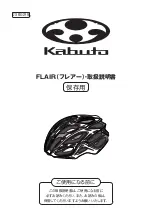
w w w . m a g u r a . c o m
s e r v i c e @ m a g u r a . d e
1.
Always make sure that the quick release skewers of your wheels and seat post
are correctly mounted and closed.
incorrectly installed quick release skewers might cause the fixed items to
get loose. Serious falls with heavy bodily injury might be the result!!
2
. Always make sure that the brake lever pressure is o.k. by pulling the lever blade
and ensuring that full braking performance is achieved before the lever blade touches
the handlebars. If this is not the case, pull the lever blade several times (pump) until the
brake pads touch the rotor.
In case, of changing pressure points during a ride you might have air in the brake
system.
See hints about filling and bleeding from on pages 15/16.
w w w . m a g u r a . c o m
s e r v i c e @ m a g u r a . d e
4
5
3
. Always make sure that the brake system does not have any leaks by activating
the lever blade, holding it and checking the hose connections and reservoir cover for
eventual leaks. (Also see page 11)
4.
Always protect your rotors and brake pads from oil and lubricants (e.g. by lubri-
cating your chain). Avoid detergents and soap on the brake pads. Contaminating the
pads with oil and lubricants will cause a permanent loss of braking power. Those pads
are definitely killed and cannot be saved. They have to be replaced. Clean a contamina-
ted rotor with dishwater or alcohol.
See further hints about the brake pad change on pages 11- 13.
5
. Release your brake lever and check whether your wheel moves freely and without
drag. Check eventually whether the wheels are correctly mounted and if the quick relea-
se skewers are sufficiently tightened. (Also see page 9)
6.
Are your tires in a good condition, and are they sufficiently pressurized? Test this
with your fingers. Lift up your bike and turn the wheels of your bike. An insufficient rotati-
on might be due to damaged tires, broken axles and/or broken spokes.
7.
Pick up your bike and let it drop from a moderate height. Be careful in case of
any rattling noise. Check the bearings and all screwed connections.
8.
Always follow the instructions given in the owner’s manual of your bicycle.
Never use your bicycle if ever a proper function of the points mentioned
above is not guaranteed. Consult a professional bike mechanic if you feel unsu-
re. A faulty bicycle might cause serious accidents with possible fatal injuries of
the rider!
Always check carefully the following points:
1.
Are you already familiar with hydraulic disc brakes? Our brakes might be much
more powerful than the stoppers on which you relied on so far.
Take your bicycle to a safe area to learn the proper braking technique and operation of
your new brakes and your bike.
2. Check whether you activate the front brake with the brake lever, which
you are used to braking on the front. If ever this is not the case you will have to
train your new setup because any unintended braking might cause an accident
with possible heavy bodily injury. Change the hose connection by a trained
technician in case of any doubts.
Further hints concerning the swapping of the brake hose see page 10 onwards.
3. New brakes and new rotors or brake pads must always be run in by
breaking at least 30 times from a speed of 30km/h to achieve the maximum
brake power. Take your bike to a safe place to run in the brake.
4. In case of extreme riding conditions (total weight of bike plus rider
over 100kg and/or a gradient of more than 15%) always use both brakes
simultaneously to brake your bike down.
5
. Do not use the Clara and Julie disc brake for downhill sport or on tandems! Any
misuse might cause heavy accidents with fatal injuries for you and others!
6.
Are you familiar with the other components on your bike such as shifting, clipless
pedals and suspension units? Always train the perfect handling of your bike in a safe
area before using it in the public traffic. Consult the user’s manual of your bike to learn
more about this.
7.
For your own safety always wear a helmet when you ride a bicycle. Make sure as
well that your clothing and footwear are suitable.
2. Before the first ride
3. Before every ride
In case of a disc brake equipped bicycle you should always keep in mind
the following points:
Never activate the lever blade without the brake pads in place and the wheels moun-
ted. In case this should have happened see page 10 of this manual.
Never throw away the transport device, which has been delivered with the brake.
Always clip it between the brake pads whenever the wheel is removed (e.g. transport of
the bike).
Always carefully removed wheels. Make sure that the rotors are not damaged,
deformed or contaminated with lubricants.
Do not transport the bike upside-down.
For a transport in an aircraft you can leave your brake as it is, e.g. you do not have
to empty it.
4. Transport of the bicycle




























